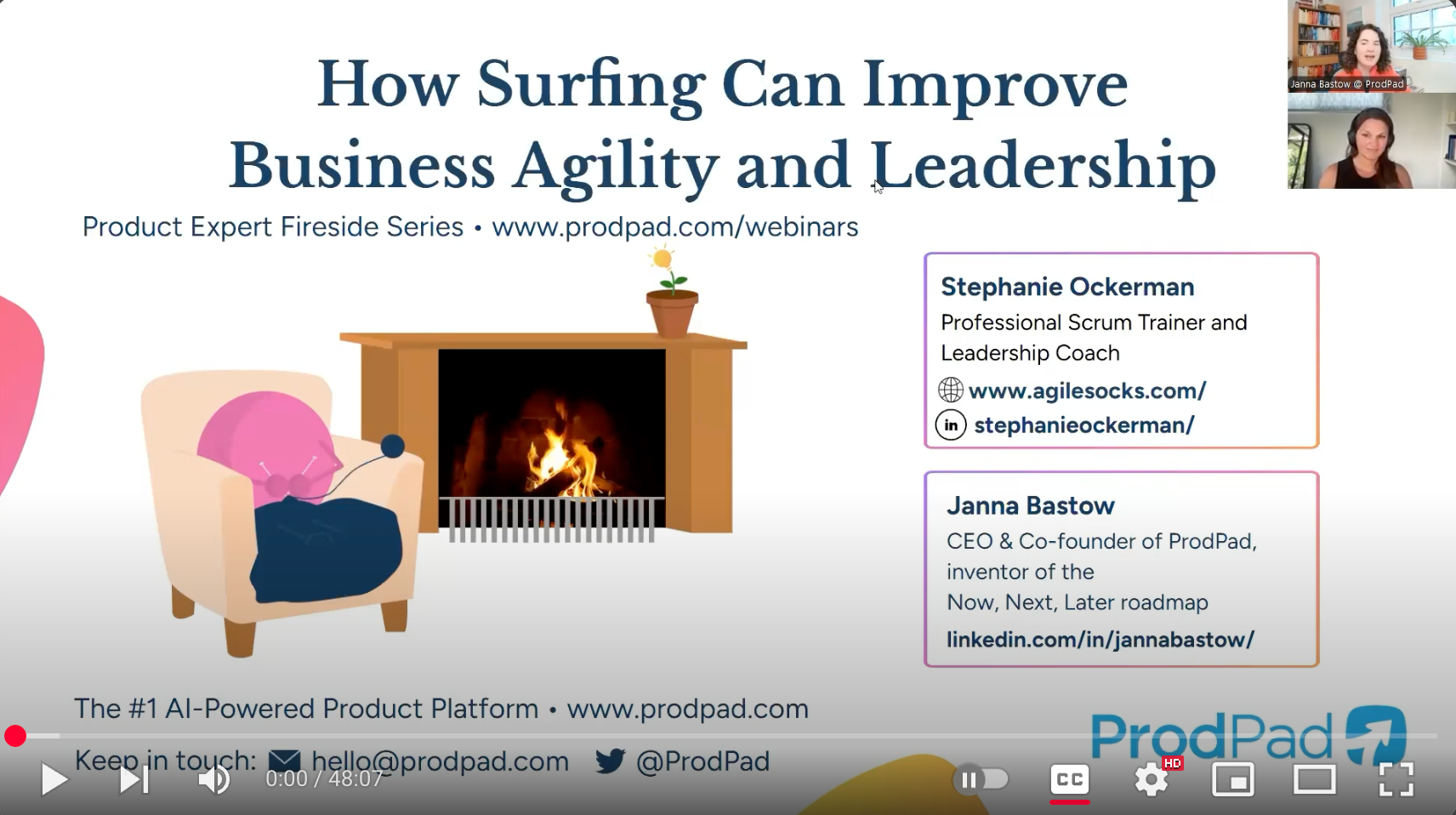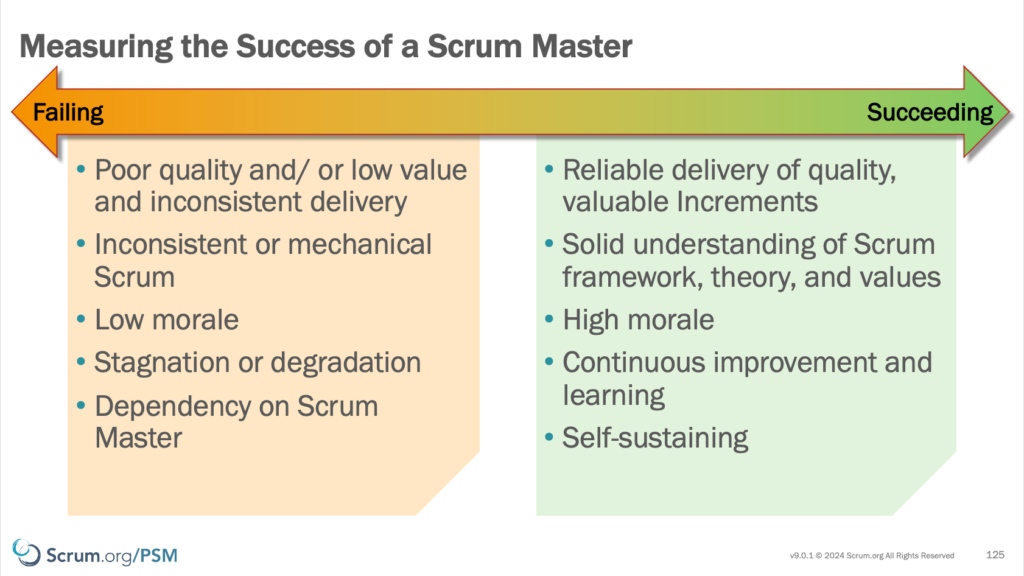
In my experience, understanding how we measure success as a Scrum Master can be challenging. And of course, it’s something Scrum Masters have a strong desire to understand.
This is also what the trends show us from the thousands of people in over 100 countries who are using the free Scrum Master Improvement Self-Assessment. We have a survey item that specifically speaks to this question: how do I measure success as a Scrum Master?
So that is what we are going to unravel and create some clarity around in this article. Let’s start with aligning on the Scrum Master accountability.
The Scrum Master is accountable for establishing Scrum as defined in the Scrum Guide and for the Scrum Team’s effectiveness.
So the first part is about helping people understand Scrum theory and how to put it into practice. However, it is not just about making sure people “follow the Scrum rules”. The true meaning is about understanding the WHY behind the elements of Scrum and the rules that bind them together.
A Scrum Master plays a big role in helping Scrum Teams embrace and integrate an Agile Mindset and an empirical way of thinking and approaching their work, as well as figuring out how they will work as a self-managing, cross-functional team and move through challenges, successes, and failures together.
A wide range of skills come into play such as teaching, facilitation, and coaching. Also skills like applying flow metrics and designing experiments. And Scrum Masters have to make choices about what skills to employ given where the team is, where they want to go and the current situation.
Now let’s look at that second part of the accountability.
Scrum Masters are accountable for the effectiveness of the Scrum Team.
That sounds a bit scary, doesn’t it? You are not “in charge”. And you know you’re not supposed to be telling the Scrum Team how to work (that would undermine ownership and self-organization). And even if you did, you cannot control other people or the variables in your environment. Really, it comes back to servant leadership.
Scrum Masters are measured by the growth and success of their Scrum Teams. That’s the job we signed up for. And we need to get more comfortable with not having control, and the fact that others will judge our success by things we cannot control or predict. Because that’s going to happen.
So we know that we care about measurable outcomes in Scrum, and Scrum aims to deliver value. But we have to bring in some nuance here. We have to look at multiple factors that contribute to success.
In the Scrum.org Professional Scrum Master ™ (PSM) class, we use the slide show below. And it is one of my favorites because it helps to capture the complexity of the topic of measuring success.

Is our team reliably delivering quality, valuable Increments? After all, this is the entire point of Scrum, and it’s what enables those business agility benefits.
Do our team and others we support in the organization have a solid understanding of Scrum framework, theory, and values? This goes back to not just knowing the rules of Scrum and treating it as a checklist of things to follow. Because that leads to a more mechanical implementation of Scrum that doesn’t align with the intentions.
Are we bringing an Agile Mindset and embodying an empirical approach?
Does our team have high morale? Engaged, motivated teams are likely to sustain their growth and continue to improve, more effectively navigate challenges, and be more resilient when they do encounter challenges and setbacks. Any outward-facing outcome-based successes can easily go away if people are experiencing low morale, especially for a sustained period of time.
Are we working at a sustainable pace or burning ourselves out or engaging in unhealthy conflict to get the work done?
Are our team and others we support in the organization experiencing continuous improvement, learning, and growth? This might look like improving product quality, growing skills across the team, increasing business or domain knowledge, delighting customers, better collaboration and more innovation, getting to Done sooner.
This may also look like improving organizational processes and policies so that they enable Scrum Teams to be more effective. It may be improving strategic planning processes to better incorporate an agile mindset, create clear outcome-based goals to guide teams, increase transparency to progress, enable earlier feedback loops, and make it easier to change direction with less waste as we learn new information.
Do we have self-sustaining Scrum, or does it all fall apart if the Scrum Master is on vacation or leaves for a new opportunity?
You may have noticed the arrows at the top of the slide. This is not meant to be a checklist or scorecard to assess a Scrum Master but more for a Scrum Master to reflect on how their team is doing and what actions they are taking to help the team move further to the right.
Success is a broad spectrum, and there are many factors that affect success.
A team may be experiencing the “succeeding side,” but the Scrum Master isn’t contributing to that progress. And that can go away. A Scrum Team may be experiencing the “less successful side,” and the Scrum Master is doing a lot to help them shift towards the right.
It requires asking ourselves the question, what direction are we trending? And then, what am I doing as a Scrum Master to influence this factor in a positive direction?
Balancing all of these aspects of success is what makes the Scrum Master role so challenging and also so fulfilling.
This is plenty for you to ponder and start assessing your opportunities. But you know what? This isn’t the end. I will be publishing a second part in this series on how to measure success as a Scrum Master.
If you haven’t taken advantage of the Scrum Master Improvement Self-Assessment yet, it is a free resource available to you now. Together with Comparative Agility, Scrum.org offers a self-assessment to help you grow as a Scrum Master. This tool helps you evaluate your Scrum Master skills and assess areas for improvement based on the Professional Scrum Competencies.
Scrum.org, Professional Scrum Training, Professional Scrum Master are trademarks of Scrum.org and may be registered in the United States Patent and Trademark Office and in other countries.



AGILE SOCKS is a registered trademark of Agile Socks LLC. Other marks used herein are the property of their respective owners. For more information see Trademark Notice in Terms & Conditions.